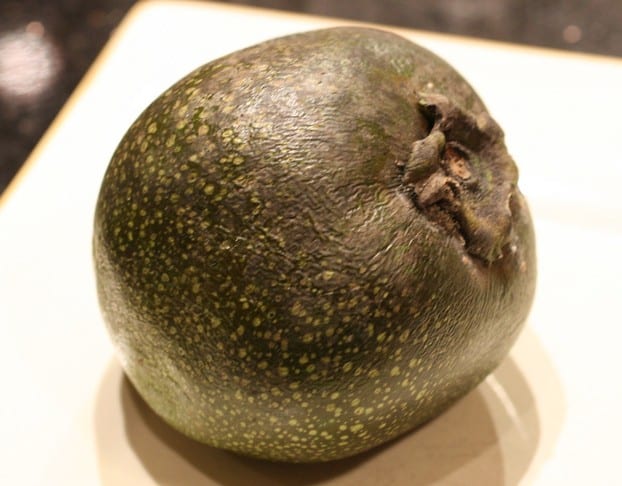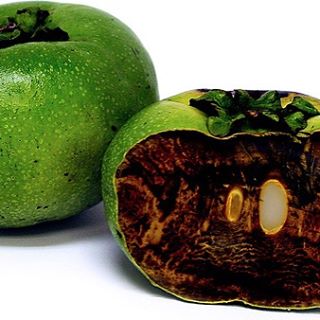Have you ever dream of growing a chocolate on a tree? Or wishing to try a fruit that tastes like chocolate? This unusual tree will make your wishes come true. Not only the Black Sapote fruit has a chocolate-like flavor, but it’s also a healthy alternative to chocolate. Black Sapote, also called Chocolate pudding fruit (Diospyros nigra), is a tropical plant cultivated for its tasty, chocolate-like flavor fruits. Native to Central America, Black Sapote is a culinary delight in Mexico, Guatemala, Caribbean, Colombia and Central America. The tasty Black Sapote fruit can be eaten raw, but it can be used as an ingredient in desserts, smoothies, and various beverages. Learn how to grow your own Black Sapote and how to enjoy its healthy and delicious fruits.

What is a Black Sapote?
Black Sapote is a wonderful tropical tree famous for its fruits that look like bright-green tomatoes, but taste like chocolate. The Black Sapote fruits grow on lovely trees with long, glossy dark green leaves. The fruits are bright green at first and not edible at this stage. The fruit gradually becomes olive-green or dark green as it slowly ripens. The fruit’s shell is thin and smooth, but the ripe fruits are left with the wrinkled shell. The jelly-like pulp is initially white, but the mature and ripe has a brown, almost black, juicy and sweet pulp.
Unripe fruits are said to be astringent, bitter, and irritating, so the optimal time for harvesting and consuming is just before the full maturity. Pick the fruit while it’s still olive-green and leave it for a couple of days to ripe. Harvest time for Black Sapote fruits varies through December to February and June to August, depending on climate zone and weather conditions.

If you have a plenty of space in your garden or backyard, feel free to grow this unusual plant. But remember that Black Sapote tree is not favored for landscaping in urban areas, cause ripe fruits can fall and smash on the ground, forming an unattractive dirt.
Different cultivars of Black Sapote are grown in Australia, Philippines, and Florida, with various sizes, shapes, and sweetness of fruit. If you want to grow this tree, consider ‘Maher’ cultivar which is highly prized for its size and can be cultivated in gardens. If you want a fruit with an excellent flavor, try ‘Cocktail’ selection for example.
Most of the Black Sapote varieties are self-fertile. Tubular flowers may have male and female organs at the same time, but some of them bear only male flowers. Some varieties may be self-incompatible and therefore require cross-pollination with another variety.
An interesting fact is that the Black Sapote is not, as the name suggests, related to the sapote (Pouteria sapota) or the white Sapote (Casimiroa edulis). This plant is not a part of the Sapote family. Actually, it is allied to the persimmon in the family Ebenaceae.
Growing Black Sapote Tree
This slow-growing, vigorous, evergreen tree can grow to over 80 ft (25 m) in height. It can spread its wide, furrowed trunk to 30 inches (75 cm) in diameter, so Black Sapote trees must be spaced 25 ft apart from each other. This tree needs some space to grow at its best.

Location
Besides plenty of space, Black Sapote requires a warm subtropical or tropical climate and it’s grown in USDA Zones 10 and 11. It prefers hot and sunny locations, sheltered from strong winds. Planting in full sun position is recommended for best growth and fruit production.
Temperature
This plant cannot withstand temperature drafts and it should be protected from frost, especially during the first few years. The mature plant tolerates mild cold and can bear temperature down to -28 F (-2 C).
Soil
Black Sapote tree prefers soil that is rich in organic material, but it will grow well in all soil types, as long as the soil is well-drained. It will adopt to any kind of soil. But remember to keep the soil slightly moist since the plant is resistant to moist soils. Actually, it can’t tolerate prolonged drought, so it requires regular watering, especially while the plant is still young. Once the plant has grown and developed deep and strong root system, you can water it only during long, dry periods. Black Sapote is not demanding in its fertilizer requirements.
Propagation
Propagation is possible from seeds, air layering, and grafting. The Black Sapote tree is possible to grow in pots and containers, but you have to prune it regularly to control its size. Otherwise, pruning and cutting are not necessary since Black Sapote grows naturally well-branched. But if you want to control the size of Black Sapote tree prune it soon after danger of frost has passed.
Common Problems with Black Sapote Tree
Pests and diseases are uncommon, but in rare cases, Black Sapote tree and fruits can be infected by spider mites, scales, and cochineals. If you notice any of these, use appropriate pesticide.
Health Benefits of Black Sapote
Unfortunately, these delicious and healthy fruits haven’t achieved any great popularity outside of its homeland. Mexicans like to mash Black Sapote pulp and mix it with orange juice or brandy, or then serve it with whipped cream; in the Philippines, the tasty fruit is served as dessert with a little milk or orange juice. It is also made into ice cream or a liqueur that resembles brandy. But, it can be simply enjoyed when eaten raw without any additional ingredients. You can eat it like an avocado – split it into two halves and eat juicy, pudding-like pulp with a spoon.
Black Sapote fruits have a good amount of A and C vitamins. It is even said that a single Black Sapote fruit contains four times the amount of vitamin C found in an orange. This amazing fruit will also provide you with various minerals such as potassium, phosphorous, calcium, iron etc. All these make Black Sapote fruit a small ‘energy booster’ which will give you an instant dose of energy. This low-fat sweet treat also contains beneficial fibers, which are good for digestive processes.
Buying Black Sapote Online
If you are looking to purchase black sapote online, you can typically find the tree seedlings available to purchase. This will allow you to try to grown your own black sapote fruit at home.